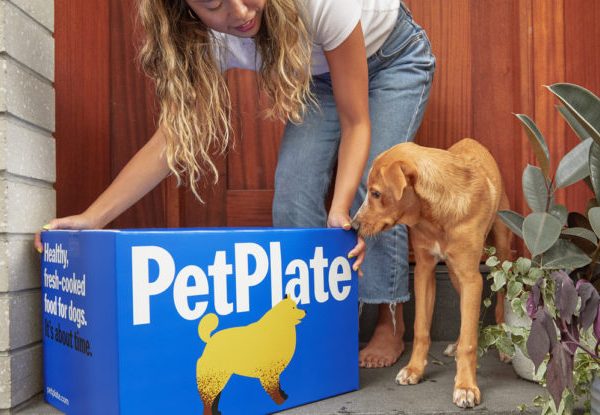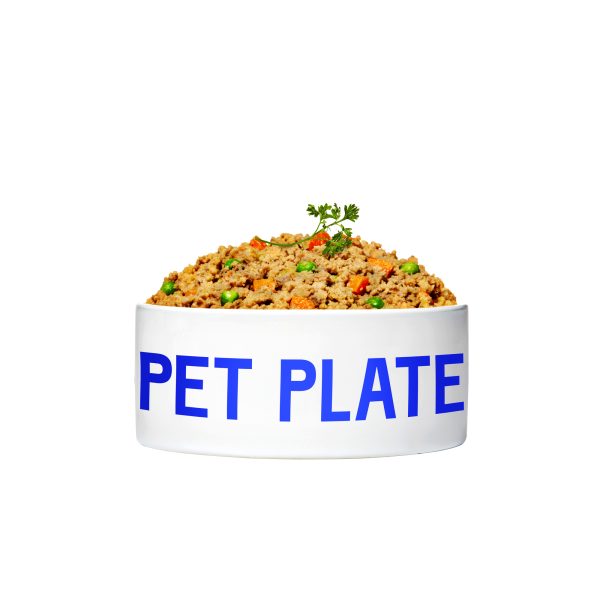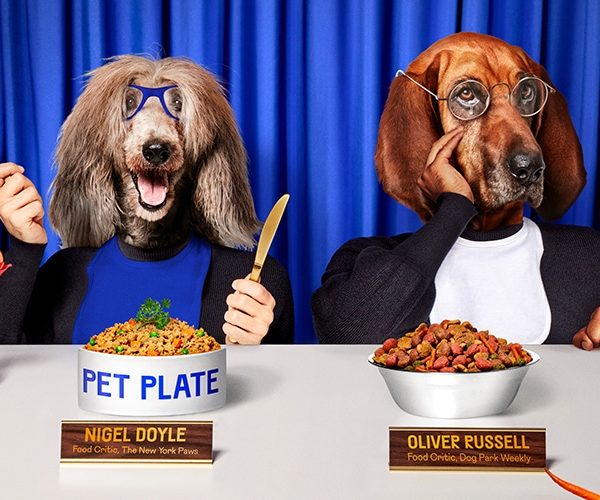
IS PET PLATE 2040’s HOTTEST DOG FOOD BRAND?
Via Kinship
“I think I could make a better pet food company.”
For an MIT physicist whose company propels itself entirely with data, Renaldo Webb makes Pet Plate’s origin sound deceptively cavalier. The freshly made, human-grade dog food delivery service was born of his desire to feed his pet better, but looking back, he’s aghast as only a founder can be at what he didn’t know he didn’t know.
“That’s literally the amount of thought I put into it before I quit my job and started cooking dog food,” he says. “Now obviously I thought about the formulas, and I’d need a vet nutritionist, so I knew all that stuff…but in terms of business strategy, it was about that basic.”
Yet, is it? Webb has certainly had some luck (even though he didn’t score funding on Shark Tank, reruns act as an ad for the company), but in the five years he’s been building up gourmet dog food delivery, he’s guided his novel idea through uncharted waters, steering by core business principles and data-derived decisions. With so many brands persisting as more loss than leader (looking at you, Uber), Pet Plate has grown profitably in lean times by keeping its bottom line in check and its top line growing.
“Investing heavily in the customer experience and customer retention allowed PetPlate to stay lean and nimble,” Webb admits. “It allowed us to grow the top-line with less marketing dollars and for us to build deeper relationships with our customers. Now that we’ve grown as a company, that thinking is still part of our DNA and we’re seeing the benefits of that hard work now.”
He and CEO Gertrude Allen have opted to stay consistent, placing customer experience and feedback on twin pedestals, and following the analytics to fine-tune their offering. Pet Plate’s goal is to show up better than everybody else and let the results speak for themselves. To do this, it’s focused on efficacy and the judicious application of often-limited resources.
Step lightly and listen to the tune changes
When you’re a small organization you can usually pivot quickly, but the weight of doing so falls heavier on your team. Webb’s 2016 debut saw him cooking the food himself at a commercial kitchen in Brooklyn for a hundred loyal customers. One year and an unfunded Shark Tank appearance later, Pet Plate was processing thousands of orders nationally via venture capital from other sources—but only once it could find a human-quality food processing plant that wanted to take on a pet-food client.
That search led the company to shepherd’s pie/pot pie manufacturers, who were essentially making the same product. But to keep things moving, it had to simultaneously build a team that could pivot from local delivery to national distribution, manage a supply chain, and build a digital marketing campaign via Facebook ads.
Webb says, “We looked for, and are still looking for, strategic self-starters. Things move and change so quickly in an early stage startup, so it is important for all of our employees to be strategic in their decision-making process to ensure their projects are supporting the company’s long-term goals. We focused primarily on retention and efficient new customer acquisition.”
By 2018, Pet Plate could refine its product with customer feedback and the latest science. Grain-free food was on the rise as more attuned with pets’ evolutionary needs. Except that’s when the FDA announced it would investigate whether peas and potatoes—common ingredients in grain-free pet foods—were linked to dilated cardiomyopathy (DCM) in dogs. (A Journal of American Science study recently stated no link could be substantiated, though more research will be done.) Pet Plate had to reinvent while still discovering itself. Out went potatoes, in went wild rice.
Retooling and solving for problems like these has demanded the business stay nimble to prosper: a strategy that paid off in February of this year with Series A funding from 301, Inc.
…which was just in time for coronavirus. The pandemic has been a roller coaster for pet products, particularly online shopping and subscription services—retail spending surged approximately 46%, then hit a cliff, while e-commerce is up 77% from last year (thanks to food picking up what other pet products dropped), with subscriptions up 28%. Chewy.com sales rose 135% this year. But while shelf-stable foods saw a surge, fresh meals were a little more of a question mark: they can only be stockpiled in a freezer. Would consumers embrace premium dog food delivery with their own employment uncertain?
Pet Plate certainly has. A year that began by producing its ten millionth meal is on track to deliver the twentieth, too. So yes, there’s luck on the unpredictable fronts, like when a global pandemic brings new customers to your door (or rather, you to theirs), but only because of a half-decade of prudent operations by Webb & Allen. Pet Plate’s business has doubled every couple of months from April through August.
But its team recently doubled in size to sixteen people, too, and it wasn’t at the production line. It was another nimble decision to staff more desks.
Exert yourself first where you need to grow most
Five years ago, you could call Pet Plate with your concerns and reach Webb himself (probably while he was at the grill, making your dog’s dinner). “The problems were so apparent because I was talking to everyone,” he says. With a hundred addresses on his NYC delivery map in his first year, all the pain points were anecdotal, and were resolved on a personal basis.
Customer retention back then was more about compatibility with busy New York lifestyles and cramped fridges—not a dissatisfied return to kibble. Webb focused on the problems he could solve, make note of recurring ones, and adjust production to eliminate them. In this way, he won some customers back with changes like eco-friendly, all-recyclable packaging.
Prior to its Series A funding, Pet Plate faced tough choices around new product launches and marketing channel expansions. “We weren’t able to be as aggressive with our marketing budget or our product roadmap to drive growth, but that allowed us to focus more heavily on our existing products and the customer experience,” says Webb. “As a result, we’ve better understood customer pain points, which has resulted in stronger retention and the ability to design better products for our customers now that we’ve closed the Series A funding.
Where companies focused on market expansion pour that kind of money into ads for new users, Pet Plate is nurturing extant customers into lifers, investing heavily in its customer experience team. As Pet Plate amasses a subscriber base of ten thousand and growing, supply-side is pretty smooth, but its top priority is customer satisfaction, which Webb says is the hardest thing to do at scale. “It’s really important for us to dive into the data and understand what people may not be articulating.”
As the sample set swells, data points necessarily give way to insights and analytics. Pet Plate’s strategic planning is born from customer asks: supplements, cat food, and human-grade, all-organic pet treats are all on the agenda for Q4 and 2021. That same feedback led to a year of testing before all-organic sausage bites debuted in 2020. Thanks to open channels with buyers, the DTC outfit is also looking at meal options for dogs with specialized dietary needs.
Succeed at your own speed
When you go from 100 customers to moving 10 million meals a year, how do you keep the fundamentals intact? How do you make customers stick? And how do you preserve efficiency while growing the team? Pet Plate conducts its trade like someone’s always watching, because someone always is.
“We really focus on keeping the integrity of core business metrics as we scale,” says Webb. “Without that you don’t really have a business. Savvy investors will be able to see through the smoke and mirrors.”
At any size, Webb is building for profitability, focusing on the advantages of a DTC company, even if they’re slower than retail. Even before pandemic nestled its roots into the world, Pet Plate rejected the topline revenue-focused, direct-to-consumer playbook of bringing in customers without regard for profitability.
“It’s not in our DNA to embrace inefficient marketing spend for the sake of growth, as we’ve all seen how that can backfire on DTC businesses,” Webb says. “However, by focusing heavily on our most successful channels and being obsessive about the customer experience and reasons for churn, we were able to quickly grow the business in 2017 and 2018.”
“We’re not trying to scale to take over the market by operating at a loss,” he adds. “We’re really focused on maintaining our business metric integrity as the company scales. In twenty years, I want everyone to be talking about Pet Plate as if it were the food you’re automatically thinking of feeding when you get a new puppy. To build that business, it doesn’t matter if we don’t hit $100 million in sales this year it’s going to happen. I would much rather have a higher margin than rushing to get there quickly and not having all of the business fundamentals there.”
Play to your strengths & pick your battles
Webb aims for a visible level of excellence that makes its own case. His quarry is measurably superior data for his product, currently focused on its nutrition and palatability. If he can show you more nutrition per bite without any filler, then Pet Plate is selling customers healthier dogs at a comparable price point to off-the-shelf dog food, rather than a premium.
“Healthy kibble is supposed to be 80% absorbent,” says Webb. “Pet Plate is over 95 for all of our dishes for digestibility. The metabolizable energy and bio-availability of Pet Plate far exceeds other product formats on the market,” and he wants to do deeper studies whose insights he can make publicly available next year. He also wants to put their findings to a peer-reviewed study for proof, and is eyeballing partnerships with vets and universities to do so.
“I always go back,” he says, “to something my mom told me as a kid: ‘Renaldo, just try to be two times better than the next person.’ When I think about metrics, when I think about how I want to position the business: that’s what we’re trying to do.”


